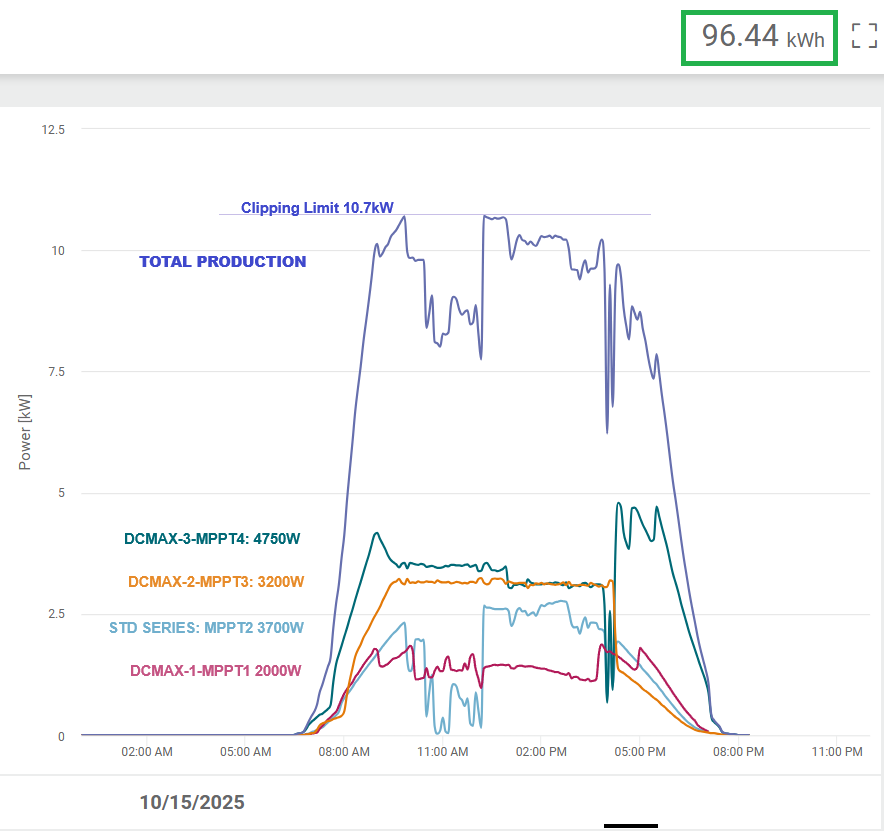Solar & Clean Energy
At Galkam Solar, we aim to support Australia's clean energy transition through cutting-edge solar technology and compliance-driven design. Our flagship product, the DCMax Smart Solar Combiner, is AS/NZS 5033 compliant and allows system designers to oversize solar arrays while still claiming STC credits
Learn more about the DCMax: Product Document
Comparing DCMax Rated array with conventional string
DCMax News - Mid October 2025
October 15th 2025: New Record Production Day
We had a new record production day on October 15th - lovely blue sky day at around 25C. We managed to capture over 96kWh of energy - going mostly into the BYD Battery, Hot Water battery and the EV but helped by shorter negative Feed-In Tarrif (FiT) that started around 8am and ended at 4pm. You can see we still didn't capture it all - so we predict it wont be long before we hit that 100kWh in a single day milestone. So far in October we have produced 923kWh: on track for a 3 month average of 1800kWh per month.

September 2025 - Negative Feed-In hits production
This months production is down over August due to Negative FiT (but still higher than Summer)
.As the test site is on Amber's wholesale plan, when solar is not needed on the grid, Feed In Tarrif (FiT), the price paid to the customer when they export, goes negative. In other words, you have to PAY to get rid of any excess production. We use the VOLTELLO monitoring tool from Village Energy to monitor the Amber FiT. When this is negative, it tells the inverter to just cover the household usage (including any vehicle or battery charging). What this means is that valuable production is simply lost and we wont be charged for excess solar. We estimate the true production would have been very close to 2MWh for September: accounting for the lost production, this is a further increase over 2022 of 175%
August 2025 - Production OUT OF SIGHT!
DCMax achieved incredible results in August. More than 200% above the 2022 Value.
At the end of 2022, I looked at my Solar results for the year. WOW! The winter months are a killer. In that moment, the idea for the DCMax was born.
Here are the real world numbers for our test site (in blue):

We are showing this years results against the 2022 year results for a comparison. The blue section indicates how much more the DCMax test site produced in 2025 over the 2022 results. Remember we have not changed the inverter or the rated value of the system. 10kW is the max inverter capacity allowed for single phase by the grid operator and the standard limits the oversizing to 13.33kW.
You can see why we are so happy with this result. The July 2022 result was 807kWh. This year we achived 1482kWh. That is 184% of the 2022 result! (and getting close to double). The August numbers 1918kWh: out performing the best summer result ever by almost 130kWh. In August 2022 we only managed 925kWh, this year we MORE than doubled this result with 207% above the 2022 result. September 2025, affected by Negative FiT, still achieved 1785kWh and including the lost FiT production, this is 175% over 2022 results.
STC Eligibility and Inverter Sizing (CER Clarification)
Following clarification from the Clean Energy Regulator (CER), we confirm that Small-scale Technology Certificates (STCs) are calculated solely on the installed solar panel capacity (kWp).
- STCs are based on the total nameplate rating of all panels installed.
- The inverter size, rating, or any “overrating limit” does not affect the number of STCs.
- System configuration, curtailment, or optimisation technology (e.g. DCMax) has no impact on the STC calculation.
CER have indicated that that the problem is complex and that they are actively working to solve this disparity. Our legal advice is that the wording of the current SAA guidelines is not lawful, and that CER and SAA must address this problem to avoid outcomes contrary to the legislation. CER also advise that the nameplate calculation may need to be adjusted to take account of DCU arrays.
DCMax installation Compliance Pathways
We have been working with the Australian Energy Regulator (AER) - while their role is tangental, they have
been strong supporters of the DCMax project. Because their role is
to ensure energy consumers have access to a reliable and secure market and that they pay
no more than necessary for energy to their homes and businesses.
they unfortunately have no specific role to play in the governance of solar installation, they are an interested party.
Example STC Calculations
The following examples show how STCs are calculated under CER rules, based only on installed panel capacity and location zone:
Typical Installation
- Location: Melbourne (Postcode Zone 4)
- System Size: 13.33 kW (maximum for a 10 kW inverter)
- Deemed Years: 6
- STC Entitlement: 94
- Approximate Value: $3,384
Alternate rules may provide a sliding scale or proportional basis for DCU arrays:
DCU Limited Installation
- Location: Melbourne (Postcode Zone 4)
- System Capacity (DCU): 13.33 kW (maximum for a 10 kW inverter)
- Deemed Years: 6
- STC Entitlement: 94
- DCU proporitional Entitlement: 66
- Approximate Value: $5,760
Last updated: 3 September 2025
Coming soon:
Our V2L2H (Vehicle-to-Load-to-Home) product, enabling integration of EVs, solar, and home energy systems with AS/NZS 4777.2 compliance.
Configure Your DCMax (coming soon): DCMax calcultor
